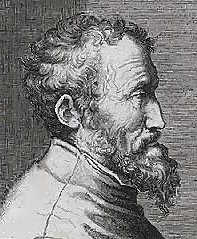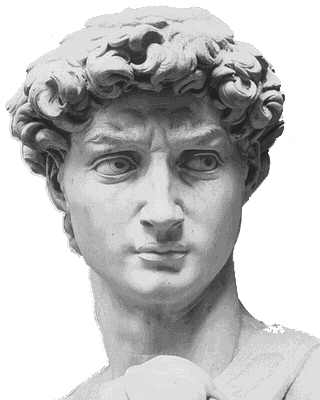Michelangelo 1475 - 1564
 Arguably one of the
most inspired creators in the history of art and, with Leonardo da Vinci, the most potent
force in the Italian High Renaissance. As a sculptor, architect, painter, and poet, he
exerted a tremendous influence on his contemporaries and on subsequent Western art in
general.
Arguably one of the
most inspired creators in the history of art and, with Leonardo da Vinci, the most potent
force in the Italian High Renaissance. As a sculptor, architect, painter, and poet, he
exerted a tremendous influence on his contemporaries and on subsequent Western art in
general.
A Florentine-although born March 6, 1475, in the small village of Caprese near
Arezzo-Michelangelo continued to have a deep attachment to his city, its art, and its
culture throughout his long life. He spent the greater part of his adulthood in Rome,
employed by the popes; characteristically, however, he left instructions that he be buried
in Florence, and his body was placed there in a fine monument in the church of Santa
Croce.

The Sistine Chapel Ceiling.
Pope Julius II recalled Michelangelo to Rome in 1505 for two commissions. The most
important one was for the frescoes of the Sistine Chapel ceiling. Working high above the
chapel floor, lying on his back on scaffolding, Michelangelo painted, between 1508 and
1512, some of the finest pictorial images of all time. On the vault of the papal chapel,
he devised an intricate system of decoration that included nine scenes from the Book of
Genesis, beginning with God Separating Light from Darkness and including the Creation of
Adam and Eve, the Temptation and Fall of Adam and Eve, and the Flood. These centrally
located narratives are surrounded by alternating images of prophets and sibyls on marble
thrones, by other Old Testament subjects, and by the ancestors of Christ. In order to
prepare for this enormous work, Michelangelo drew numerous figure studies and cartoons,
devising scores of figure types and poses. These awesome, mighty images, demonstrating
Michelangelo's masterly understanding of human anatomy and movement, changed the course of
painting in the West.

 Arguably one of the
most inspired creators in the history of art and, with Leonardo da Vinci, the most potent
force in the Italian High Renaissance. As a sculptor, architect, painter, and poet, he
exerted a tremendous influence on his contemporaries and on subsequent Western art in
general.
Arguably one of the
most inspired creators in the history of art and, with Leonardo da Vinci, the most potent
force in the Italian High Renaissance. As a sculptor, architect, painter, and poet, he
exerted a tremendous influence on his contemporaries and on subsequent Western art in
general. 
